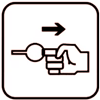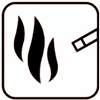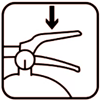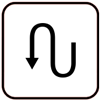With our latest series of educational articles, it’s clear everyone is now well informed about how important fire extinguishers are in combatting fires – be it residential, commercial, or even car fires. But that begs the next most important question – “How to use a fire extinguisher to fight fires?”
The short answer is to use the PASS technique – a quick and easy way to remember how to operate a fire extinguisher in an emergency.
The PASS technique
Can’t remember this simple acronym? There’s always also the instruction label on the fire extinguisher to remind you of the steps.
 | 1. Pull the safety pin | |
 | 2. Aim at the base of the fire | |
 | 3. Squeeze the lever | |
 | 4. Sweep from side to side |
However, do keep in mind that the PASS technique is a very simplified version of the efforts that go into fighting fires. It’s pared down to the basics to make it easy for a layman to remember what to do in a moment of panic.
Want to learn more about how to use a fire extinguisher to fight fires, and other relevant safety tips, read on for a detailed explanation of what you need to do at every step of the way.
Fire fighting starts before the fire happens
How do we fight a fire before it even happens? Well, it boils down to good planning!
The simple truth is that all fires are easy to put out if the occupants of the room are prepared, know what types of fire to expect and which fire extinguishers can be used to fight them.
The most serious mistake one can make in firefighting is to use the wrong type of fire extinguisher against a fire it cannot possibly fight. For example, in the case of kitchen fires, one should only use rated Class F fire extinguishers. If a powder-type fire extinguisher is used erroneously, it will only cause the fire to grow faster.
Having said that, while some fire hazards cannot be completely eliminated, planning will help you tackle any unexpected fires. Be familiar with the fire extinguishers that are near you and the possible fire hazards, so that you can make sure that suitable fire extinguishers are accessible in cases of emergencies and you know what to do!
This is why we should take our fire drills seriously!
When the fire happens…
In the unfortunate situation that a fire breaks out, here’s what you should do.
Calmly head towards the nearest fire extinguisher and do a quick check, if possible, to see if the pressure gauge is in the green zone (in operable condition). At the same time, alert the other occupants nearby of the fire so that they can get more help.
Next, once you removed the fire extinguisher from its position, it’s time for step 1 of the PASS technique – pull the safety pin.
Once the safety seal is released, squeeze gently to give the extinguisher a quick squirt to check that it’s not empty and is operating well. Do not squeeze too hard as you want to reserve every bit of fire extinguishing agent inside for the actual fire.
In the cases where nothing is released (due to the extinguisher having leaked while the gauge needle is jammed in the position giving the illusion it’s still pressurized), it’s time to head quickly to look for the next closest fire extinguisher.
Make sure you don’t forget this quick squirt as it is incredibly dangerous to head close to a fire, squeeze the handle only to find out it is empty.
This is also the reason why we recommend everyone to have at least two fire extinguishers – in the case one is not in operable condition.
While walking to the fire…
Once you have an operating fire extinguisher, the next step is to head toward the source of the fire. While en route, make sure to continue alerting all occupants in the vicinity so they can escape. Break the fire alarm control point if you see it to trigger the alarm. If you see a second fire extinguisher, try to bring it along.
If you managed to get help from another person. Get that second person to head to the nearby fire hose reel to prepare the hose reel. The fire hose reel takes about 2-3 minutes to pull out and drag to the scene of the fire, but it has unlimited water and would be what SCDF uses when they reach. Preparing it ahead while the SCDF is on the way would save them precious minutes when they arrive.
This is important because while the fire extinguisher is amazing at putting out incipient or small fires, it only lasts seconds. The hose reel is the backup in case the fire extinguisher alone is not enough to put out the fire. This combination of firefighting tools is very effective against most small to medium-sized fires.
Fighting the fire
Once you’ve arrived at the source of the fire, you should position yourself at a safe distance where you can aim your nozzle at the fire – where it’s time for steps 2 and 3 of the PASS technique – aim at the base of the fire and squeeze the lever.
At a safe distance, look for the base of the fire and squeeze the lever to discharge the contents of the fire extinguisher. At 3m, almost 50+% of firefighting powder will never directly hit the fire. We start from a distance to avoid inhaling toxic fumes and slowly try to move closer. So, if it’s safe to do so, try moving closer for a more accurate discharge.
Too far away and the fire will not be hit by the extinguishing agent. Too close and you may get burnt. Hence the idea is to maintain a good balance between your safety and the distance that allows you to successfully put out the fire. However, when in doubt, don’t risk it.
To sweep or not to sweep?
Now that you’re in the middle of discharging the contents of the fire extinguisher, you’ve reached the final step of the PASS technique – sweep from side to side.
This makes sense only if the area of the fire is large! Using a sweeping motion from side to side will help you get the discharge to smother as many parts of the fire as possible.
However, if the fire is centralized in a tiny area, then it would not make any sense to use a sweeping motion as it will waste the firefighting agent. Instead, just focus on the base of the fire and discharge as much of the contents directly over it to smother the fire directly.
Running is always an option
Now that we’ve gone through the main steps of firefighting with the help of a fire extinguisher, we do want to remind you that running is always an option!
Remember that the point of firefighting is to firstly, preserve lives, then property. As such, always keep the door behind you open and always be prepared to run if the situation takes a turn for the worst, after all, fires can be very unpredictable.
Especially if you are alone and the fire was not successfully put out after the first fire extinguisher, you should only attempt to make another try with another fire extinguisher if the fire was almost put out or greatly reduced in size. Otherwise, abandon the fire and get yourself to safety first.
